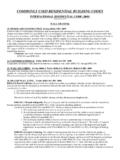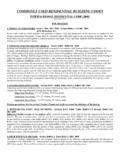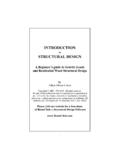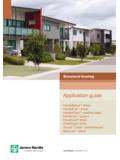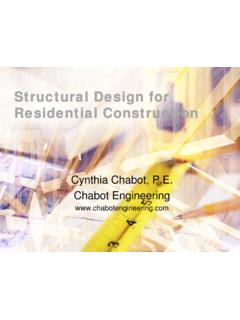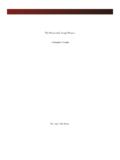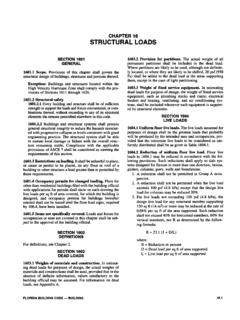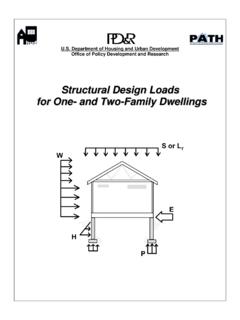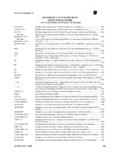Transcription of COMMONLY USED RESIDENTIAL BUILDING CODES
1 COMMONLY used RESIDENTIAL BUILDING CODES . INTERNATIONAL RESIDENTIAL code (2009). form revised 5/10. FLOOR FRAMING. 16. JOISTS UNDER BEARING PARTITIONS. Section IRC 2009. Joists under parallel bearing partitions shall be of adequate size to support the load. Doubled joists, sized to adequately support the load, that are separated to permit the installation of piping or vents shall be full depth solid blocked with lumber not less than 2 inches (51mm) in nominal thickness spaced not more than 4 feet (1219 mm) on center. Bearing partitions perpendicular to joists shall not be offset from supporting girders, walls or partitions more than the joist depth unless such joists are of sufficient size to carry the additional load.
2 17. FLOOR JOIST SPAN. Section IRC 2009. Spans for floor joists shall be in accordance with Tables (1) and (2). For other grades and species and for other loading conditions, refer to AF&PA Span Tables for Joists and Rafters. Sleeping areas and attic joists. Table (1) shall be used to determine the maximum allowable span of floor joists that support sleeping areas and attics that are accessed by means of a fixed stairway in accordance with Section provided that the design live load does not exceed 30 psf ( kPa) and the design dead load does not exceed 20. psf ( kPa). The allowable span of ceiling joists that support attics used for limited storage or no storage shall be determined in accordance with Section Other floor joists.
3 Table (2) shall be used to determine the maximum allowable span of floor joists that support all other areas of the BUILDING , other than sleeping rooms and attics, provided that the design live load does not exceed 40 psf ( kPa) and the design dead load does not exceed 20 psf ( kPa). 18. JOIST BLOCKING. Section IRC 2009. Joists shall be supported laterally at the ends by full-depth solid blocking not be less than 2 inches (51 mm) in nominal thickness; or by attachment to a full-depth header, band, or rim joist, or to an adjoining stud; or shall be otherwise provided with lateral support to prevent rotation. Exceptions: 1. Trusses, structural composite lumber, structural glue-laminated members and I-joists shall be supported laterally as required by manufacturer's recommendations.
4 19. JOIST HEADERS. Section IRC 2009. Openings in floor framing shall be framed with a header and trimmer joists. When the header joist span does not exceed 4. feet (1219 mm), the header joist may be a single member the same size as the floor joist. Single trimmer joists may be used to carry a single header joist that is located within 3 feet (914 mm) of the trimmer joist bearing. When the header joist span exceeds 4 feet (1219 mm), the trimmer joists and the header joist shall be doubled and of sufficient cross section to support the floor joists framing into the header. Approved hangers shall be used for the header joist to trimmer joist connections when the header joist span exceeds 6 feet (1829 mm).
5 Tail joists over 12 feet (3658 mm) long shall be supported at the header by framing anchors or on ledger strips nor less than 2 inches by 2 inches (51 mm by 51 mm). 20. NOTCHES & HOLES IN FLOOR JOIST. Section IRC 2009. structural floor members shall not be cut, bored or notched in excess of the limitations specified in this section. Sawn lumber. Notches in solid lumber joists, rafters and beams shall not exceed one-sixth of the depth of the member, shall not be longer than one-third of the depth of the member and shall not be located in the middle one-third of the span. Notches at the ends of the member shall not exceed one-fourth the depth of the member.
6 The tension side of members 4 inches (102 mm) or greater in nominal thickness shall not be notched except at the ends of the members. The diameter of the holes bored or cut into members shall not exceed one-third the depth of the member. Holes shall not be closer than 2 inches (51 mm) to the top or bottom of the member, or to any other hole located in the member. Where the member is also notched, the hole shall not be closer than 2 inches (51mm) the notch. Engineered wood products. Cuts, notches and holes bored in trusses, structural composite lumber, structural glue-laminated members or I-joists are prohibited except where permitted by the manufacturer's recommendations or where the effects of such alterations are specifically considered in the design of the member by a registered design professional 21.
7 WOOD structural PANEL SUBFLOOR. Section & , Tables (1) &. (2) IRC 2009. Where used as subflooring or combination subfloor underlayment, wood structure panels shall be one of the grades specified in Table (1). When sanded plywood is used as combination subfloor underlayment, the grade shall be as specified in Table (2). 22. MOISTURE CONTROL FLOORS. Sec. Washington State Energy code (WSEC) 2009. Floors separating conditioned space from unconditioned space shall have a vapor retarder installed. The vapor retarder shall have a one perm dry cup rating or less ( four mil. polyethylene or kraft faced material). The vapor retarder should be installed on the warm side of the cavity to be insulated.
8 2. 3. 4. 5. 6. 7. 8. 9. 10. 11. 12. 13. 14.
